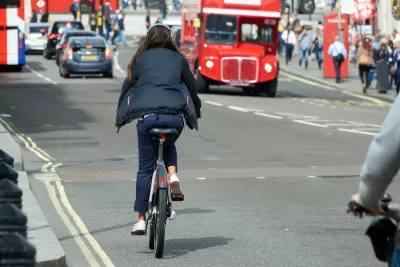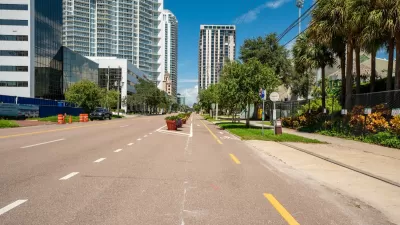Bike infrastructure isn’t just about bike lanes: safe, supportive spaces where adults can learn to ride and repair bikes are a key component.

Safe, protected bike lanes and connectivity to transit are important factors in supporting more cycling. But, Alison Griswold writes in Bloomberg CityLab, “The social infrastructure of urban cycling — programs that give people the skills, tools and confidence to get on two wheels — can be just as important as physical infrastructure, especially when it comes to bridging access gaps.”
Around the world, rates of cycling for women are significantly lower than for men, due to a host of factors from harassment to to infrastructure. “For many decades, the streets of cities around the world have largely been built around the mobility preferences of men.”
Social and educational programs that help people learn to ride and feel confident on bikes can help close the gap. “In the UK, Transport for London reported last June that uptake of adult cycle training sessions was ‘particularly strong among some traditionally under-represented cycling groups,’ with 76% female participants and more than 40% from Black, Asian, and other ethnic minority backgrounds.” Griswold provides examples of other education programs, but notes that few adult bike education programs exist in comparison with programs aimed at children. The popularity of biking helps, too: “A 2021 survey of cycling behavior in 17 countries and 35 major cities found women biked as much as men when cycling’s overall mode share exceeded 7%.” Sadly, only a few global cities meet that threshold.
FULL STORY: The Other Kind of Bike Infrastructure Cities Need

Planetizen Federal Action Tracker
A weekly monitor of how Trump’s orders and actions are impacting planners and planning in America.

San Francisco's School District Spent $105M To Build Affordable Housing for Teachers — And That's Just the Beginning
SFUSD joins a growing list of school districts using their land holdings to address housing affordability challenges faced by their own employees.

Vehicle-related Deaths Drop 29% in Richmond, VA
The seventh year of the city's Vision Zero strategy also cut the number of people killed in alcohol-related crashes by half.

Downtown Portland Ready for Maine's Tallest Building
The city of Portland anticipates a major new urban development addition called the “Old Port Square” project.

The EV “Charging Divide” Plaguing Rural America
With “the deck stacked” against rural areas, will the great electric American road trip ever be a reality?

Judge Halts Brooklyn Bike Lane Removal
Lawyers must prove the city was not acting “arbitrarily, capriciously, and illegally” in ordering the hasty removal.
Urban Design for Planners 1: Software Tools
This six-course series explores essential urban design concepts using open source software and equips planners with the tools they need to participate fully in the urban design process.
Planning for Universal Design
Learn the tools for implementing Universal Design in planning regulations.
Borough of Carlisle
Smith Gee Studio
City of Camden Redevelopment Agency
City of Astoria
Transportation Research & Education Center (TREC) at Portland State University
City of Camden Redevelopment Agency
Municipality of Princeton (NJ)





























